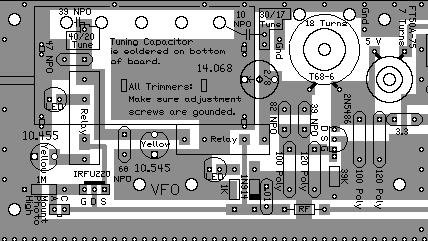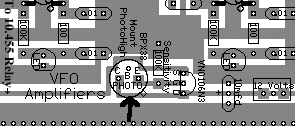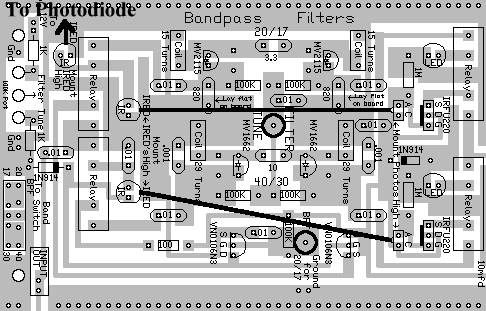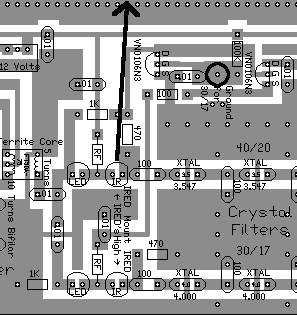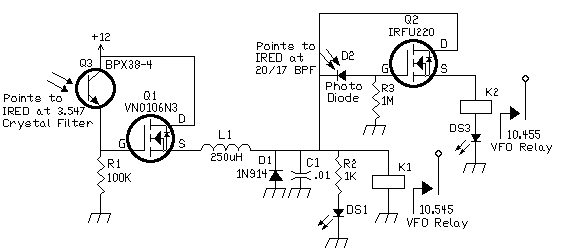Circuit Operation
When no IR is hitting the BPX38-4 (Q3), Q1 is turned off. When IR hits Q3 from the 3.547MHz crystal filter IR LED, Q1 is turned on by the increase in gate voltage. Then 12 volts is sent through the 250uH choke to the 10.545 relay and LED.
If 20 meters is chosen while the 10.545 relay is on, IR turns on the photodiode (D2), which raises the gate voltage of Q2 to turn-on and the 10.455 relay and LED are turned on.
The 1N914 (D1), with C1 (.01), protects the gate of Q2 from voltage spikes off the relays.
R1 at the Q1 gate sets the sensitivity for the BPX38-4. The higher the gate resistance, the higher the sensitivity. Q1 needs to be turned on hard to supply enough current to turn on two relays and LEDs. That is why the gate resistance is 100K (R1), whereas the resistance for the BPX38-4 at the crystal oscillator is only 47K.
The LED (DS1) at the 10.545 relay may be changed to a super-bright LED, which you see in most of the pictures of the bottom board.
A super-bright LED cannot be used at DS3, as the higher forward voltage drop of the super-bright LED will not allow the 10.455 relay to draw enough current to turn on. A regular LED must be used here with the normal 1.6 to 2.0 forward voltage drop.
The diode tester on a VOM/DVM measures the forward voltage drop of an LED. A Super-bright LED forward voltage drop is 3 to 4 volts, whereas the Bright Reds and regular LEDs run between 1.6 to 2.0 volts.
The relays have a 500 ohm coil resistance, which serves as the limiting resistance for DS3. A 1K resistor is used in series with DS1 to limit current.
Construction Tips
The transistors used in this circuit must have very high gate impedance. A 2N5486 will not work in this circuit, you must use single-gate MOSFET/MESFETs or similar devices. The VN0106N3's are similar to VK1010's, which are more common, and work great in the circuit.
Mount photo devices with all their lead length as high as possible above the board to make aiming easier. Bend the phototransistors parallel with the board before soldering them into the PCB, since they are so short.
If you are using the receiver "open face", as in the front cover photographs, shop lights may modulate the VFO with 60 cycle AC current. The incandescent light modulates the phototransistor, changing current flowing through the relay.
The varying magnetic field changes the permeability of the iron-powder VFO core (T68-6), and can move the frequency tens of hertz. Be especially leery of this when first testing the receiver on the bench, using your regular shop light for illumination.
Black plastic tubing, dark straws, black heat shrink tubing, and black rubber tubing can be used to cover the IR paths making the phototransistor/photodiodes immune to ambient light levels.
During frequency stability tests, the IR paths must be covered. Sunlight moving through a room during the day will change the frequency of the VFO.
Relay Problems
If the 3.547 crystal filter LED is on, and the 10.455 relay does not turn on when the bandpass filter is on 20 meters, short the "C" and "E" pins of the phototransistor at the VFO amplifiers and see if the relay turns on.
If it does, then check two things:
First, there may not be enough IR energy hitting the BPX38-4 to turn on the VN0106N3 enough to supply the correct current. When first testing a new board, most of time I have forgotten to aim the IREDs! Find the IRED at the 3.547 crystal filter and check for proper alignment.
Second, the receiver voltage may not be high enough. The power supply for the receiver must run 12 to 13 volts. If it runs near 11 volts, the switching on the board may not work.
Larger RF chokes, using large size wire for lower resistance, should be placed at the 12 Volt connection to the board going to the supply trace for the BPX38 and relays.
The same type RF choke can be placed at the RF choke position next to the poly caps at the VFO. This will lower the resistances in the 12 Volts supply line and raise the voltage level.
The value of the RF choke is not critical. Any value from 10uH to 1mH can be used. A choke can be wound on an FT50-43 or FT37-43 ferrite core, with 10 to 20 turns, whatever will fit with the wire you have available.
If you have nothing available, just short the chokes with wires. There will probably be no degradation of receiver performance that will be noticed.
|


